Brunei |
|
|
|
| Übersicht – Contents: | |
Diese Seite ist Teil des Projektes
Brunei |
|
|
|
| Übersicht – Contents: | |
Flaggen – Flags: |
|
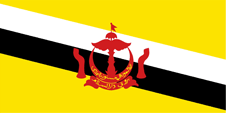 |
Nationalflagge, Staatsflagge und Gösch – national flag, state flag and naval jack, Seitenverhältnis – ratio = 1:2, Quelle/Source nach/by: Corel Draw 4, Flags of the World |
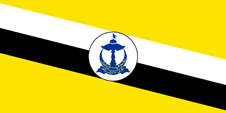 |
Dienstflagge zur See – offshore official flag (?), Seitenverhältnis – ratio = 1:2, Quelle/Source: Die Welt im bunten Flaggenbild |
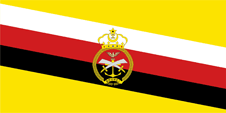 |
Flagge der Streitkräfte (Kiegsflagge) – flag of the armed forces (war flag), Seitenverhältnis – ratio = 1:2, Quelle/Source nach/by: Flags of the World |
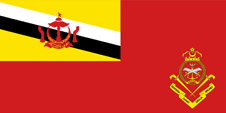 |
Flagge des Heeres – flag of the army, Seitenverhältnis – ratio = 1:2, Quelle/Source nach/by: Flags of the World |
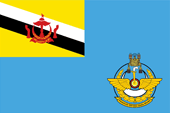 |
Flagge der Luftwaffe – flag of the Air Force, Seitenverhältnis – ratio = 2:3, Quelle/Source nach/by: Flags of the World |
 |
Marineflagge – naval flag, Seitenverhältnis – ratio = 1:2, Quelle/Source nach/by: Flags of the World, Wikipedia (DE) |
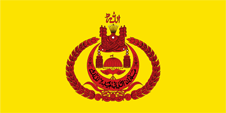 |
seit/since 1999, Standarte des Sultans – standard of the Sultan, Seitenverhältnis – ratio = 1:2, Quelle/Source: Hubert Herald, Flags of the World |
historische Flaggen – historical Flags: |
|
 |
bis/to 1906, Nationalflagge – national flag, Seitenverhältnis – ratio = 1:2, Quelle/Source nach/by: Flags of the World |
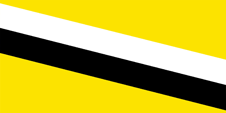 |
1906–1959, Nationalflagge – national flag, Seitenverhältnis – ratio = 1:2, Quelle/Source nach/by: Flags of the World |
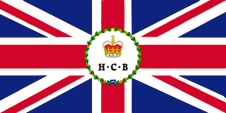 |
1959–1983, Flagge des Hohen Kommissars – flag of the High Commissioner, Seitenverhältnis – ratio = 1:2, Quelle/Source nach/by: Flags of the World |
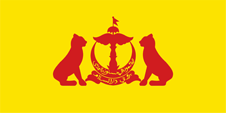 |
1959–1999, Standarte des Sultans – standard of the Sultan, Seitenverhältnis – ratio = 1:2, Quelle/Source: Hubert Herald |
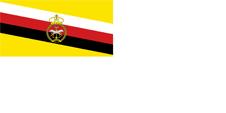 |
ca.1990–ca.2010, Marineflagge – naval flag, Seitenverhältnis – ratio = 1:2, Quelle/Source nach/by: Flags of the World, Wikipedia (EN) |
Bedeutung/Ursprung der Flagge – Meaning/Origin of the Flag: |
|
| Die Flagge von Brunei wurde im Jahr 1906 eingeführt. Sie ist gelb mit einem breiten weiß-schwarzem Diagonalstreifen. Das Staatswappen wurde 1959 eingefügt. Nach Erlangung der Unabhängigkeit (01.01.1984) wurde die Flagge unverändert beibehalten. Gelb ist im gesamten hinterindischen Raum die Farbe des Königtums. In Brunei symbolisiert es somit die Herrschermacht des Sultans. Weiß und Schwarz waren bzw. sind in fast allen malaiischen Staaten Farben zur Kennzeichnung der monarchischen Hierarchie: Weiß ist die Farbe des Premierministers (Temenggong) und Schwarz die Farbe des Zweiten Ministers (Bendahara). Als Farben für die Flaggen werden angegeben: Gelb = pt 102, Rot = pt 032 und Schwarz. | The flag of Brunei was
introduced in the year 1906. It is yellow with a wide white-black diagonal stripe. The
coat of arms of the state was added in 1959. After the achievement of independence (1st of January in 1984) the flag was maintained unchanged. Yellow is in the whole back-indian area the color of the kingship. In Brunei it symbolizes herewith the might of the ruling sultan. White and black were or are the colors for marking of the royal hierarchy in the almost Malay states: white is the colour of the Premier (Temenggong) and black is the colour of the Second Minister (Bendahara). The colors given for the flags are: yellow = pt 102, red = pt 032 and black. |
| Quelle/Source:
Die Welt der Flaggen,
Flaggen und Wappen der Welt,
Flags of the World Translator of the English text: Joachim Nuthack |
|
Wappen – Coat of Arms: |
|
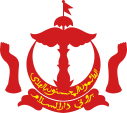 |
Wappen von Brunei – coat of arms of Brunei, Quelle/Source: Corel Draw 4, Wikipedia (EN) |
Bedeutung/Ursprung des Wappens – Meaning/Origin of the Coat of Arms: |
|
| Das Staatswappen enthält bekannte islamische Symbole: einen Halbmond und einen Baldachin (Schirm). Der Baldachin ragt aus dem liegenden Halbmond heraus. Seit 1959, Brunei bekam in diesem Jahr eine Verfassung, stehen links und rechts des Wappens je ein Unterarm. Die arabischen Inschriften auf dem Halbmond und in einem Schriftband darunter lauten: "Durch Gottes Hand wird das Gute gedeihen" und "Brunei, Heimstatt des Friedens". | The coat of arms
contains known islamic symbols: a crescent and a canopy (parasol). The canopy towers above
the lying down crescent. Since 1959 – Brunei got in this year a constitution –
stand to the left and on the right of the coat of arms ever one forearm. The Arabian inscriptions on the crescent and underneath in a typeface ribbon say: "Through gods hand the good will thrive" and "Brunei, home of peace". |
| Quelle/Source:
Flaggen Wappen Hymnen Translator of the English text: Joachim Nuthack |
|
Flugzeugkokarde – aircraft roundel: |
|
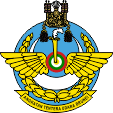 |
seit/since 1991(?), Flugzeugkokarde – aircraft roundel, Quelle/Source nach/by: Flags of the World, Wikipedia (EN) |
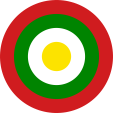 |
1975–1991(?), Flugzeugkokarde – aircraft roundel, Quelle/Source nach/by: Flags of the World |
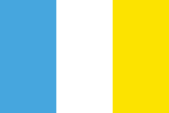 |
Markierung am Seitenleitwerk – Fin Flash, Quelle/Source nach/by: Flags of the World |
| Landkarte – Map: |
Lage – Position: |
Landkarte
des Landes – Map of the Country: |
heutige
Länder in der Region – today's countries in the region: |
Zahlen und Fakten – Numbers and Facts: |
|
|
|
|
|
|
|
|
|
|
|
|
|
|
|
|
|
|
|
Geschichte: |
| 14. Jahrhundert
· die Region gehört zum Reich Madschapahit 1363 · Gründung von Brunei (bestehend aus dem Territorium der heutigen Länder Sarawak, Brunei und Sabah) 1410 · Islamisierung 1578 · Spanien okkupiert Brunei für drei Monate 1704 · Brunei tritt den Osten von Sabah an das Sultanat Sulu ab 24.09.1841 · als Verdienst für die Niederschlagung eines Aufstands tritt der Sultan von Brunei Sarawak an den Briten James Brooke ab 1847 · Großbritannien nimmt Brunei in Besitz 17.09.1888 · Abtrennung von Britisch-Nordborneo (Sabah), Brunei wird britisches Protektorat 1890 · Abtrennung von Labuan und Angliederung an Britisch-Nordborneo 05.12.1905 · Brunei wird britisches Protektorat unter einem britischen Residenten, der das Land nach außen vertritt, der Sultan bleibt für Innenpolitik und Religion zuständig 1942–1945 · von japanischen Truppen besetzt 1945–1946 · britische Militärverwaltung 29.09.1959 · Großbritannien gewährt Autonomie, Annahme einer Verfassung, der Islam wird Staatsreligion 1962 · Aufstand, Verhängung des Ausnahmezustands 1967 · Krönung von Sultan Hassanal Bolkiah 23.11.1971 · Großbritannien gewährt vollständige innere Selbstverwaltung 01.01.1984 · Großbritannien gewährt Unabhängigkeit 1998 · Sultan Hassanal Bolkiah bestimmt seinen ältesten Sohn Prinz al-Muhtadee Billah zum Kronprinzen |
History: |
| 14th century
· the region belongs to the Empire of Majapahit 1363 · establishment of state of Brunei (consisting of the territory of the modern countries of Sarawak, Brunei and Sabah) 1410 · Islamization 1578 · Spain occupies Brunei for three months 1704 · Brunei cedes the east of Sabah to the Sulu Sultanate 24th of September 1841 · as a merit for the suppression of an uprising occurs the Sultan of Brunei, Sarawak to the British James Brooke 1847 · the United Kingdom takes possession of Brunei 17th of September 1888 · separation of British North Borneo (Sabah), Brunei becomes a British protectorate 1890 · separation of Labuan and annexation to British North Borneo 5th of December 1905 · Brunei becomes a British protectorate under the rule of a British resident who will represent the country abroad, the Sultan is in charge for inner politics and religion 1942–1945 · occupied by Japanese troops 1945–1946 · British military administration 29th of September 1959 · United Kingdom grants independence, adoption of a constitution, the Islam becomes the state religion 1962 · rebellion, state of emergency 1967 · coronation of Sultan Hassanal Bolkiah 23rd of November 1971 · United Kingdom grants full internal self government 1st of January 1984 · United Kingdom grants independence 1998 · Sultan Hassanal Bolkiah determines his eldest son Prince al-Muhtadee Billah to Crown Prince |
| Quelle/Source: Atlas zur Geschichte, World Statesmen, Wikipedia (D) |
Ursprung des Landesnamens – Origin of the Country's Name: |
|
| Der Name des Landes hat seine Wurzeln im chinesischen Wort "Poni", der als "Brunei" Name der gesamten Insel Kalimantan, und zum Namen des auf der Insel gelegen Staates wurde. Europäische Seefahrer und Händler machten im 16. Jahrhundert aus dem Wort "Brunei" das Wort "Borneo", als Name für die Insel. | The name of the country has its roots in the Chinese word "Poni", which became as "Brunei" to the name of Kalimantan Island, and to the name of the on the island placed state. European sailors and traders changed the word "Brunei" to the word "Borneo" in the 16th century, as the name for the island. |
| Quelle/Source: Handbuch der geographischen Namen, Wikipedia (D) | |